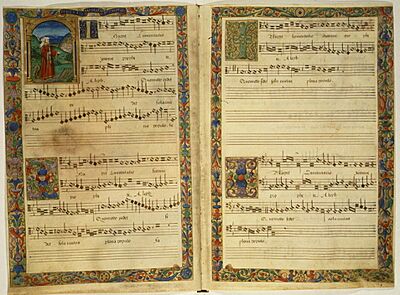Carpentras (composer) facts for kids
Carpentras (also known as Elzéar Genet) was a famous French composer who lived during the Renaissance period (around 1470 to 1548). He was well-known for his beautiful musical pieces called Lamentations. These pieces were so good that they were sung by the Papal Choir (the Pope's own singers) for many years. Carpentras was also one of the most important musicians from the city of Avignon in a long time.
Life of Carpentras
Carpentras was born in a town also called Carpentras. We don't know much about his early life. Before 1505, he became a church official, which is why he was called a "clericus" when he started working in the Avignon chapel that year. He spent most of his life going back and forth between Avignon and Rome.
He knew a bishop from Avignon named Giuliano della Rovere. When this bishop became Pope Julius II, Carpentras went with him to Rome. There, he sang in the papal chapel, which was the Pope's group of singers. This was around 1508.
After a few years, he left the papal chapel. He went to work for Louis XII of France, the King of France. We don't know much about his time there. He wrote a lot of everyday music, some of which was quite playful. When he returned to Rome in 1513, he promised to stop writing that kind of music.
In 1514, he became the leader of the papal chapel. This was under the new pope, Pope Leo X, who was from the Medici family. Pope Leo X loved music and art very much. When Pope Leo X died in 1521, Carpentras left Rome and went back to Avignon. The next pope, Adrian VI, didn't care much for music. Many musicians left Rome because of this.
When Adrian VI died in 1523, the new pope, Clement VII, was also a great supporter of the arts. So, Carpentras returned to Rome. While there, he was surprised to hear his own music being sung, but it sounded different. It had been changed! Because of this, he carefully copied some of his music, like the Lamentations of Jeremiah shown in the picture. He gave this collection to Pope Clement VII. He called it the "true" or "corrected" version of his music. However, he didn't stay in Rome for long. After only two years, he left for Avignon for good.
Around 1526, Carpentras started to have a condition called tinnitus. This meant he heard a constant hissing sound in his head, which scared him. Because of this, he stopped performing music. Instead, he decided to publish all of his sacred (religious) music. This was a huge project and one of the first times a composer tried to publish all their works.
The publishing process was difficult. One printer didn't line up the notes correctly on the music lines. The whole process even ended up in a disagreement that needed to be settled. But finally, in the mid-1530s, he was able to release four large collections of his music. He dedicated two of these books to Pope Clement VII and the other two to Cardinal Ippolito de'Medici.
In the last twenty years of his life, he held several church positions in Avignon. He died in Avignon in 1548.
Carpentras's Music
Carpentras wrote several masses (musical settings for church services). He also composed many settings of the Magnificat, psalms, hymns, and motets (types of religious songs). He also wrote some everyday songs. His most famous works were his many settings of the Lamentations. These were very popular during his lifetime.
His Lamentations were used until 1587. That's when another famous composer, Palestrina, was asked by the church to create new ones.
Carpentras's music style was typical of composers who came after Josquin. His music often had smooth polyphonic parts, meaning many independent voice parts singing at the same time. He also used a technique called imitation, where a melody is copied by different voices. Carpentras often switched between these imitated sections and homophonic sections. In homophonic music, all the voices move together, like in a hymn. This was especially true in his Lamentations.


